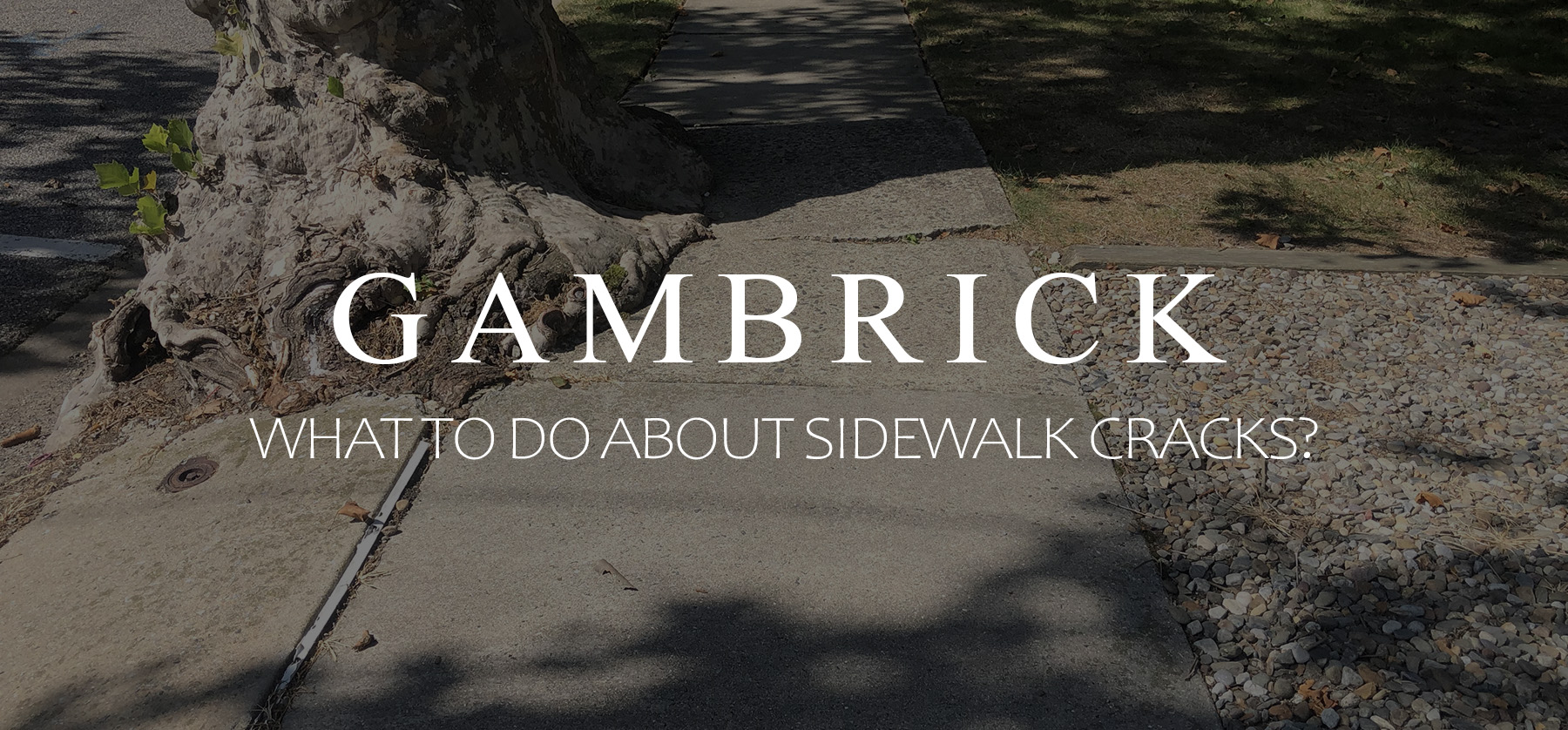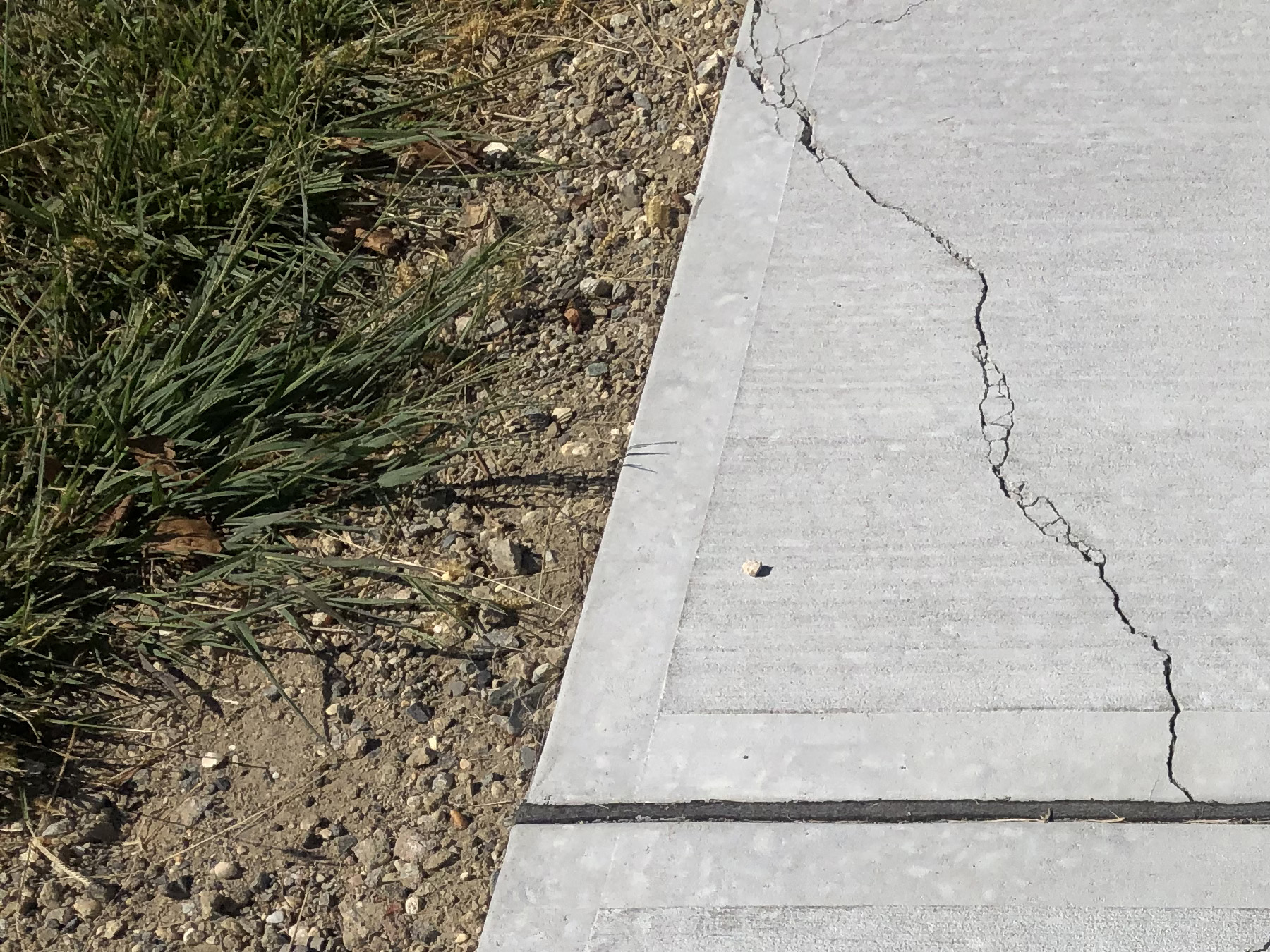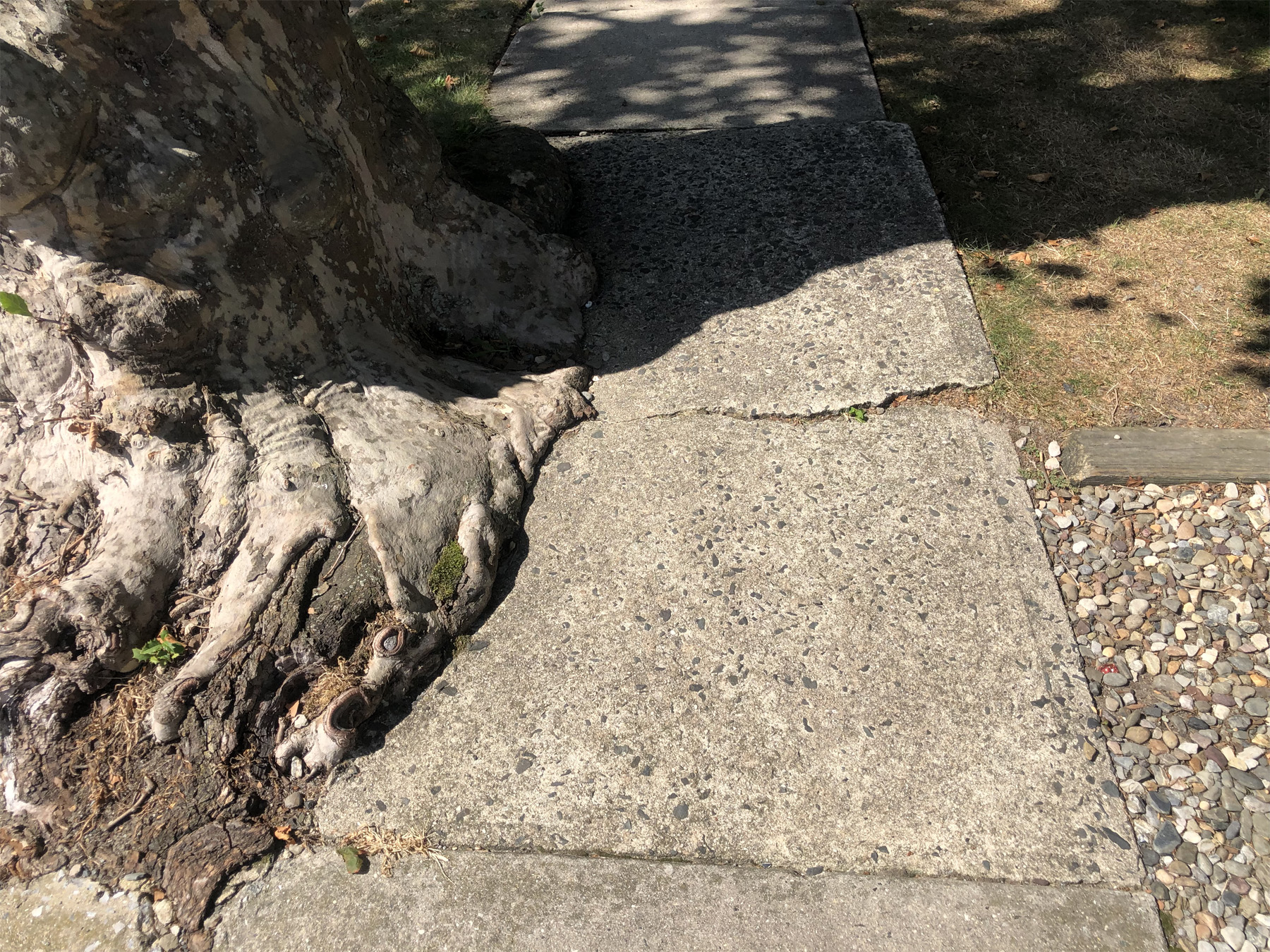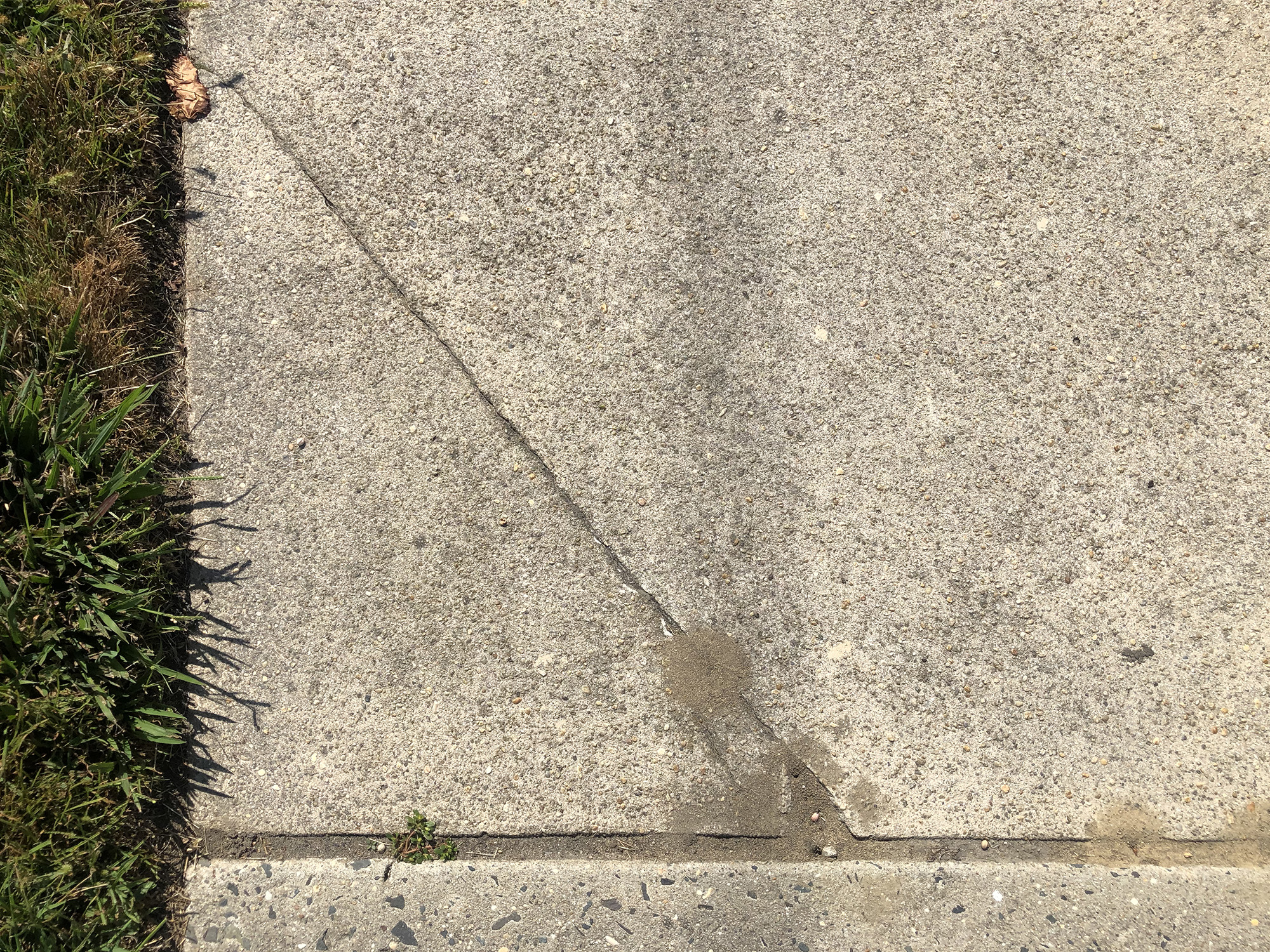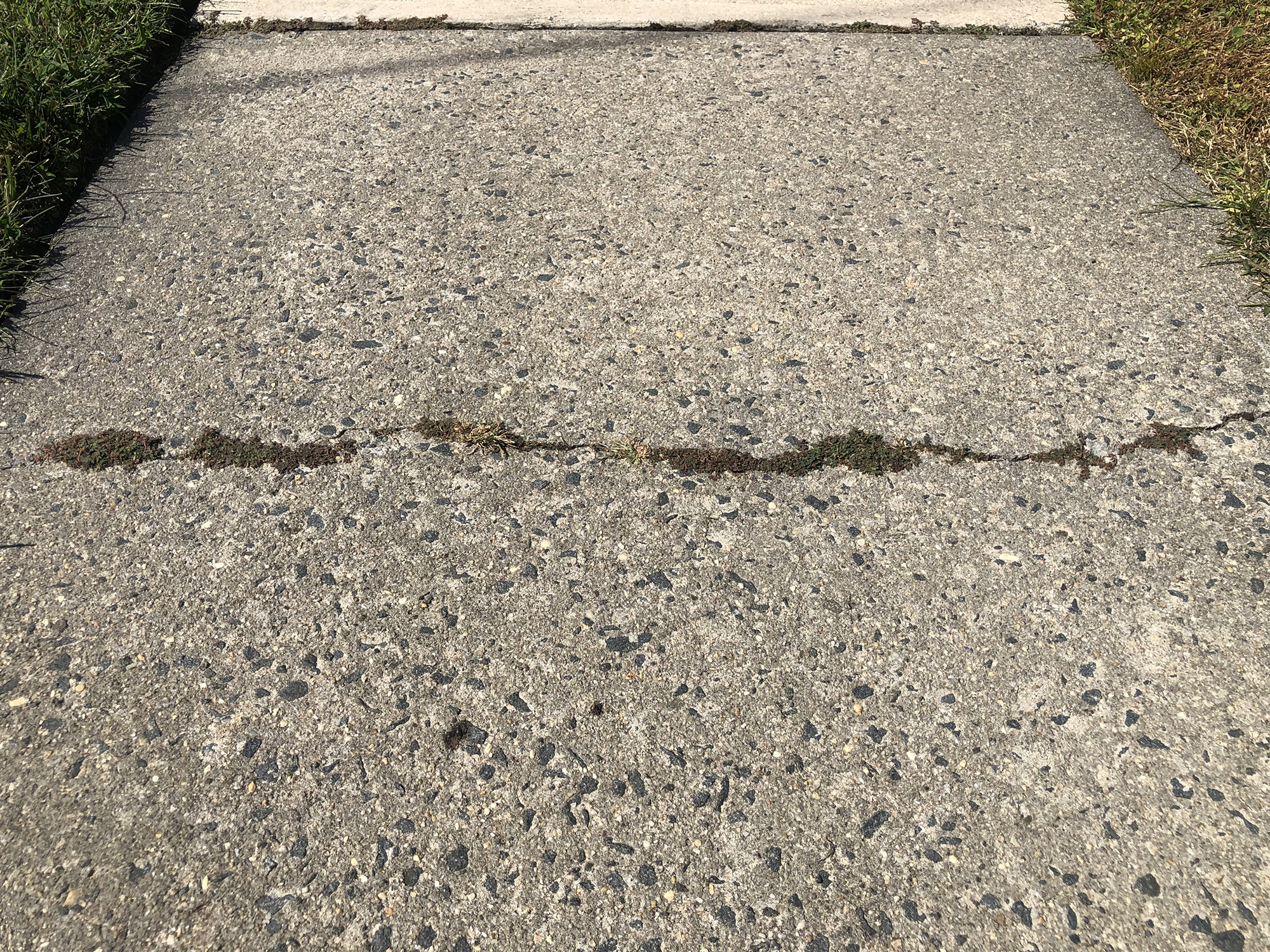What To Do About Sidewalk Cracks?
One of the most common concrete repair work we do are sidewalks. Even though they’re for public use, they’re on your property which means you’re responsible for making repairs. And unfortunately they’re very easy to crack for a variety of reasons. The main reason why concrete sidewalks crack is expansion and contraction. As the concrete heats it expands. Then it contracts again as it cools. This creates movement which causes stress and pressure. The pressure is relieved by a crack. The prevent sidewalks cracks you need expansion joints. These joints give the concrete somewhere to move so that it doesn’t crack. But what can you do about sidewalk cracks once they’re already there? Repair them or replace the section of damaged concrete.
To repair small sidewalk cracks you need a patch mix. They’re sold at Home Depot either premixed in a tub or as a semi-solid liquid that comes in a tube. Semi-solid liquid crack fillers are for fixing very small hairline cracks in concrete. It’s a good idea to fix the small cracks as soon as you find them because they could get worse. Medium size cracks should be filled with a patch mix that comes in a tub.
You can also make your own concrete patch by mixing together Portland Cement and sand with a little lime. It creates a strong mortar that’s used to fix medium sized concrete cracks.
To repair large sidewalk cracks you can either fill the crack with fresh concrete or demolish the area and pour a new section of sidewalk. Demo is usually the best option if the cracks are really bad.
In this article we’ll discuss what you can do about concrete sidewalk cracks.
What Causes Sidewalk Cracks?
Most sidewalks are just 4 inches of 3000 to 4000 psi concrete poured on a compacted gravel base. Some contain reinforcement inside like rebar or wire mesh, but some do not. There are many reasons why a concrete sidewalk cracks. Expansion and contraction, impact, age, roots, bad soil, poor quality installation and issues with the concrete are just a few.
Unfortunately, concrete sidewalks are prone to cracking for a variety of reasons. It’s very common but luckily there are a few things you can do to prevent it from happening.
Here are some of the most common reasons why a concrete sidewalk cracks:
Expansion & Contraction
The most common reason why a concrete sidewalk cracks is expansion and contraction. As the concrete heats up and then cools, it expands and contracts. This movement can create pressure that eventually cracks the concrete.
Most cracks caused by expansion and contraction start off small and are often ignored. But you should repair them immediately because the cracks will get larger over time.
To prevent cracks due to movement you need to install expansion joints.
Expansion joints are a small gap between sections of sidewalk. In a 4 inch thick sidewalk you need a control joint every 8-12 feet. Control joint can be installed before the concrete is poured or after it’s set by using a concrete saw.
Expansion joints are filled with a flexible material which seals the joint but allows movement.
Soil Erosion
Soil erosion is another common cause of sidewalk cracks.
Sidewalks should be built on a strong and stable base of soil and compacted gravel. But not all soil is created equal. Some areas get more rain than others and are prone to erosion.
If you’ve had a lot of rain or flooding and your local soil tends to be loose, it’s possible you could get some erosion under the slab. Water can run underneath your sidewalk, causing the soil to run off which creates a void.
Once a void forms under the sidewalk, that section of concrete is unsupported. This can lead to big cracks depending on how large the void is.
If your sidewalk has medium to large size cracks running through it, look for a void underneath. If you find it, the void has to be fixed along with the concrete. Repairing the crack without filling the void won’t permanently fix the problem because the area is still unsupported.
A good way to prevent soil erosion is with a thick gravel base. A gravel base allows water to flow freely through it without disturbing the soil or rocks.
Settling
When a concrete sidewalk is poured the soil and gravel base need to be well compacted. For this reason it’s best to install a sidewalk on virgin soil. Compacting the soil and gravel base before you pour concrete prevents settling.
If the subgrade is not properly compacted, it can start to settle beneath the slab. This is different than soil erosion because it’s not caused by water, but the result is basically the same. If the soil beneath a sidewalk settles more is some places than others, voids form under the slab.
If all the soil beneath a sidewalk settled at exactly the same rate, a void would not form. However this rarely happens. In reality, soil settles at different rates which creates areas of unsupported concrete.
Sidewalk cracks caused by settling are worse than cracks caused by erosion. When water erosion occurs, its usually in a single spot or two that’s easy to find if you dig next to the slab. You’ll find the area where water is flowing under the concrete and can then fill it with fresh concrete, gravel or soil.
But uneven settling can happen in lots of areas which makes spot repairs much harder to do. I’ve seen entire sidewalks ruined because the ground settled unevenly underneath and caused major cracks all over the slab.
Once these cracks start to form you can repair them with a patch mix or fresh concrete. But if they’re extensive you may need to redo the sidewalk.
Sidewalks that are cracked and unlevel can be raised and leveled by a process called mud-jacking or by using foam.
To prevent sidewalk cracks caused by uneven settling, you need to properly compact the subgrade below. Compact both the soil and gravel base layer before you pour concrete.
Roots
Another common cause of sidewalk cracks are roots. You should never pour a concrete sidewalk on top of thick tree rots.
As a tree grows, it’s roots become larger which creates upward pressure under the slab. This can eventually cause a sidewalk to heave up and buckle from below. The result is a sidewalk that pops up in sections with large cracks.
If the heave is small you can grind down the concrete that’s high and fill the crack with a patch or new concrete. But this is a temporary fix. As the tree continues to grow the roots will get larger and keep pressing up on the sidewalk.
The only way to permanently fix the problem is to redo the sidewalk in the area above the root.
Here are a few options:
- You can remove the root, which sometimes means killing the tree
- Raise the sidewalk to go over the root.
- Move the sidewalk around the root.
Simply patching the concrete or redoing the slab in the exact same place won’t permanently fix the problem unless the tree is done growing. If the tree is full grown then you may be able to fix the crack or redo a small area without future damage. But if the tree continues to grow the crack will likely reform.
Poor Quality
Another common reason concrete sidewalks cracks is poor quality.
- A concrete sidewalks starts off with proper preparation. The soil and gravel base need to be well compacted before any concrete is poured. If the ground beneath the sidewalk isn’t compacted, you may get uneven settling which can destroy the slab.
- Next is the concrete itself. A sidewalks should be made out of at least 3000 to 4000 psi concrete. If the concrete is weak, improperly mixed or contains too much water, it can become brittle and crack.
- Expansion joints should be cut into the concrete after it sets or installed prior to the pour. Without expansion joints a concrete sidewalks will most likely crack.
- A thick gravel base should be installed under the sidewalk in areas that are prone to heavy rainfall. This helps prevent water erosion.
- In areas with poor soil quality, reinforcement can be used inside the sidewalk. This includes rebar, wire mesh, fiber or chemical hardeners.
- Concrete can also be thickened in areas with bad soil to prevent cracks. The standard sidewalk is 4 inches thick but I’ve poured plenty at 5 and 6 inches thick to prevent cracks.
- Don’t pour a sidewalk on top of thick tree roots. They could eventually push up through the sidewalk and cause a heave.
By using the right preparation, planning and concrete, almost all serious concrete sidewalk cracks can be avoided.
The Best Ways To Fix Sidewalk Cracks
There’s no one size fits all best product to fix sidewalk cracks. The method you use must match the type and size crack you have. To fix small hairline cracks use a liquid concrete crack filler. For medium size cracks use caulk, a concrete patch mix or mortar made by mixing together sand, Portland cement and lime. To fix large cracks use fresh concrete.
But these methods only address the surface layer. For some more serious sidewalk cracks you also have to address the underlying cause. We’ll explain the cause of most concrete cracks and how to fix them in the next section.
How To Fix Small Sidewalk Cracks
Small hairline sidewalk cracks are usually caused by expansion and contraction or drying. Concrete is poured as a semi solid that later dries and grows strong. The process is called curing. When concrete dries too fast small cracks can occur. These same tiny cracks can happen when the concrete expands and contracts.
To fix small hairline concrete sidewalk cracks, you need a liquid crack filler. They come in a small bottle with a pointed tip similar to glue. Simply pour some filler into the crack and let it dry.
Fixing small cracks are important because the filler seals them which helps prevent them from spreading.
How To Fix Medium Size Sidewalk Cracks
There are several products that work great for repairs medium sized concrete sidewalk cracks. These include:
- Concrete Patch Mix: You can buy them in tubs at any Home Depot or Lowes.
- Caulk: Make sure you use a flexible masonry caulk and not regular caulk.
- Tube Cement: Repair cement is sold in a caulk tube. It’s great for making repairs to mid sized concrete cracks.
- Mortar: You can make your own mortar by mixing together Portland cement, lime and sand with water. This is the cheapest option and great if you have lots of repairs to make.
Before you make any repairs, clean the area thoroughly using a bristle brush. Swipe away any dirt, debris or loose particles out of the crack. Then, apply a little painters tape around the edges of the crack. Tape keeps repair material off the sidewalks surface and in the crack.
Whichever product you choose to use, try to get the filler as deep into the crack as possible. Fill the crack from its base to the top of the sidewalk.
Remove the tape, clean up and let it dry.
How To Fix Large Concrete Sidewalk Cracks
Large sidewalk cracks are often a result of an underlying issue. If you find them you should do some detective work to find the root cause.
To repair a large sidewalk crack I use fresh concrete. However concrete has stones so the crack has to be wide enough for the stones to fit. This is why concrete can’t be used to repair small or medium size cracks.
One of the problems with repairing cracked concrete with new concrete is that concrete doesn’t stick to itself. To make the new concrete stick, you need a bonding agent.
First, clean the cracked area with a bristle brush. Swipe away any dirt and loose debris. Once the crack is clean, apply the bonding liquid with an old paint brush. Use a lot and thoroughly cover the area. Then mix some fresh concrete and press it into the crack with a trowel. Try to get concrete as deep into the crack as possible.
Use the trowel to get the surface as smooth and flat as possible with the rest of the sidewalk.
Use a tile sponge to clean off excess concrete around the crack.
Let the concrete dry and do a final cleanup.
What To Do If A Sidewalk Is Significantly Cracked?
If your sidewalk has serious and significant cracks, it may be best to demo the sidewalk and redo it. Seriously cracked sidewalks are usually caused by underlying issues like poor drainage, erosion, pool workmanship, bad concrete, or settling. None of these issue will be fixed simply by repairing the surface.
Cut out or break up the damaged areas of sidewalk and prep the surface for a new pour.
Make sure to clean up any small particles or chunks of old sidewalk. Then level the area with fresh gravel and tamp it down. While the ground beneath the sidewalk is revealed, look for the cause of the cracks. If you find an issue, now is the time to fix it.
Once you fix the underlying cause of your sidewalks cracks and prep the area, build your forms. I use 2x4s to build sidewalks. Then pour fresh concrete. A concrete sidewalks should use 3000 to 4000 psi concrete.
Once the concrete has set enough, use tools to finish the edge and surface. I use a broom to finish the inside areas of my sidewalks.
Make sure to install control joints every 8-12 feet. As a rule, a control joint should be every 2-3 times in feet the thickness of the sidewalk in inches. This is why a 4 inch thick sidewalk needs a control joint every 8-12 feet.
How To Fix Sidewalk Cracks Caused By Heaving
Sidewalk cracks caused by heaving are different than normal cracks because the pressure is upwards instead of downwards. The cause is usually uneven settling, erosion or roots. If your sidewalk is heaving badly, you need to demo the area, address the underlying issue and then pour fresh concrete.
If your sidewalk is only slightly heaved, you can sometimes use a grinder to grind down the high area and then fix the crack with filler or fresh concrete. However this is usually just a temporary fix because you haven’t fixed the cause of the heave.
Once you demo the sidewalk area that’s heaved, you’ll be able to see the ground below. The solution is the same for both settling and erosion, you need to pour new gravel and tamp the area thoroughly. Gravel and tamping will level the ground and help prevent future settling while providing drainage.
Once the area is flat and tamped, build your forms and pour concrete.
If the cause of heaving is roots it’s easier to determine because most times the sidewalk will be next to a large tree. In this case you have a few options:
- Raise the height of the sidewalk to clear the roots
- Move the sidewalk around the roots
- Cut the roots
Whichever option you choose, make sure to prep the area before you pour fresh concrete. Pour gravel and tamp the area thoroughly. Build forms and pour fresh concrete. If you simply pour fresh concrete on top of roots, they’ll usually break the sidewalk again as they grow.
The only time you can pour fresh concrete in the same spot right on top of root is when the tree is fully grown. If you’re sure the tree has stopped growing it’s OK to pour concrete on top of roots.
Are Sidewalk Cracks A Problem?
Sidewalk cracks can cause a variety of problems some big and some small. They should be repaired as soon as you find them because over time they get progressively worse. Even though a sidewalk is for public use it’s on your property which means it’s your responsibility to maintain.
Here are just a few of the reasons to fix sidewalk cracks as early as possible:
Tripping
The biggest reason why you should fix sidewalk cracks is tripping. If a crack gets big enough, or is caused by a heave, it could cause someone to trip and fall.
If a crack is serious enough to become a tripping hazard, you most likely have an underlying problem beneath the slab. Heaves and serious cracks are usually caused by roots, uneven settling or soil erosion. Make sure when you repair the crack that you also address the underlying cause or else the crack will most likely come back.
They Get Worse
Another thing to understand is that concrete cracks tend to get progressively worse over time. If you don’t fix the problem right away, a small crack can continue to open up and may eventually become something larger.
Fixing small cracks is cheap and easy to do. Very small cracks can be filled with a semi-solid liquid crack filler. The sealant keeps water out of the crack which helps prevent spreading. Medium cracks should be filled with a crack filler you can buy in a tub.
By filling small and medium size cracks right away you may help prevent large cracks from forming. And it’s the larger cracks that can become an expensive and hard to fix problem. If cracks get bad enough you may have to replace entire sections of the sidewalk.
Aesthetics
Almost everyone is concerned with curb appeal and sidewalks a part of that. A cracked sidewalk isn’t a good look. Especially if you plan on selling the home. No buyer wants to buy a house that needs significant sidewalk repair or replacement because it could be an expensive fix.
If your sidewalk needs serious repairs a buyer will likely ask for a credit to cover the costs. It’s almost always cheaper for you to fix the issue yourself or with your own contractor than to give a large credit.
It’s a bad look for the neighborhood if you’re the house on the block with a cracked and ugly sidewalk. Even though the sidewalk is on your property it most likely meets up with your neighbors sidewalks on either side. Keeping your sidewalk well maintained not only improves the look of your home but also the neighbors and the entire neighborhood which ultimately increases the value of your property.
Can I Just Fill A Sidewalk Crack?
Repairing a cracked sidewalk with a surface layer crack filler is a good way to make repairs. But you should also address the underlying cause of the crack. If all you do is repair the surface of the concrete, but ignore the cause, the crack may come back or get worse. The best ways to repair a cracked sidewalks surface are caulk, liquid fillers or a concrete patch mix.
To make a surface layer sidewalk repair, clean the area first. Use a stiff bristle brush to get rid of dirt, debris, etc. out of the crack. Try to remove sections of the crack that may be flaking off.
Once the crack is clean and free of debris, apply the filler. Get it as deep into the crack as possible. Try not to get filler on the concrete surface if you can. To prevent it, I like to apply some painters tape to the edges of the crack before I start applying the filler.
Once the crack is filled to the top, remove the tape and/or clean the concrete. Allow the filler to dry.
Here are a few ways to repair a cracked sidewalk along with tips on when and how to do them:
Surface-Level Fix
Caulking, crack fillers and concrete patches are all surface layer fixes. They’re great for repairing sidewalk cracks and help prevent spreading. You should use a surface level crack filler as soon as you find the crack. Fillers seal the crack which prevents water and organic material from getting into the concrete which helps prevent future cracking.
One of the problem with cracked sidewalks is that the cracks can get worse and spread over time. As the concrete starts to crack apart, water, expansion and contraction, settling, impact pressure, etc. can start to widen the cracks. But sealing the cracks helps prevent some of this from happening.
Here are a few reasons to use a surface level repair:
- Surface level fillers keep out water which prevents freezing.
- They keep out organic material which help prevent weeds.
- Improve the sidewalks appearance.
Here’s when not to use just a surface level fix:
- They don’t address the underlying cause of the sidewalk crack.
- Won’t help with heaving.
- Don’t prevent future cracks due to settling or erosion.
Surface layer sidewalk crack repairs are mostly used for appearance sake and to prevent small and medium size cracks from getting worse. But if you have large cracks, or a serious problem that caused them like erosion, settling or roots, those problems won’t be fixed by a crack filler.
Fixing Underlying Sidewalk Problems
Some cracks are too serious to repair with just a surface level fix because the problem is what’s under the sidewalk. You may have a drainage issue which is causing soil erosion, uneven settling due to improperly compacted soil, improper or missing control joints or roots.
If you have serious cracks or heaving, you need to address the underlying issue before you make repairs to the sidewalk.
Fixing the cause of a sidewalk crack takes a but of detective work. Find the major cracks and dig around the sides of the sidewalk to see what’s going on underneath. If you find voids beneath the sidewalk or really wet soil you may have erosion or settling. In these cases you have to fix not only the sidewalk but also the soil conditions below.
If you have a heaved area next to a tree the cause is simple, roots are pushing the concrete up. To fix the problem you can either cut out the roots, which may kill the tree, raise the sidewalk around the roots or move the sidewalk. Buy whichever solution you choose it will require redoing the area of concrete that’s heaved.
If the tree has stopped growing, you can cut out out the damaged section of concrete and re-pour. But this may not help if the tree keeps growing because the roots could crack the new concrete.
Fixing underlying problems that cause major sidewalk cracks usually requires demolishing the sidewalk and pouring a new one. But if you’re lucky the cracks are only in a small area and not the entire sidewalk.
Is It Normal For Sidewalks To Crack?
Some amount of sidewalk cracks are perfectly normal and unavoidable. These are the tiny hairline cracks that occur due to expansion and contraction or drying. All concrete is poured as a semi-solid that later dries and hardens which can create small surface cracks. It also expands and contracts as the temperature changes which also creates small cracks. This is normal and usually unavoidable.
However, medium to large size cracks are not normal and there’s always a cause. Usually it’s improperly spaced or missing control joints, soil erosion, uneven settling, bad concrete, poor workmanship, impacts, roots or improperly prepared soil or base.
When Should I Worry About Concrete Sidewalk Cracks?
You should address and repair all concrete sidewalk cracks as soon as you find them. However I wouldn’t start to worry until you find medium to large size cracks. If you can fit the edge of a quarter into a crack it’s big enough to cause some worry. Tiny hairline cracks are perfectly normal and shouldn’t bother you. They’re caused when the concrete dries or from expansion and contraction which you can;t do anything about. But medium to large cracks are caused by an underlying issue like settling, soil erosion, impacts, poor workmanship, roots, control joint issues, bad concrete, etc.
If you find a medium to large size crack, repair it immediately and try to locate the problem. If you can find the cause of the crack repair it right away or it could cause more cracks.
Who Is Responsible For Sidewalk Repair?
In most areas, maintaining and repairing damaged sidewalks is the property owners responsibility. Even though the sidewalk is for public use, it’s still on your land. This means you have to maintain and fix damaged areas to keep them safe. But this isn’t true everywhere. In some locations, the city maintains responsibility for fixing damaged sidewalks and will make repairs upon request. Call your local municipality to find out who’s responsibility they are.
Summary: What To Do About Sidewalk Cracks?
One of the most common concrete repair work we do are sidewalks. Even though they’re for public use, they’re on your property which means you’re responsible for making repairs. And unfortunately they’re very easy to crack for a variety of reasons. The main reason why concrete sidewalks crack is expansion and contraction. As the concrete heats it expands. Then it contracts again as it cools. This creates movement which causes stress and pressure. The pressure is relieved by a crack. The prevent sidewalks cracks you need expansion joints. These joints give the concrete somewhere to move so that it doesn’t crack. But what can you do about sidewalk cracks once they’re already there? Repair them or replace the section of damaged concrete.
To repair small sidewalk cracks you need a patch mix. They’re sold at Home Depot either premixed in a tub or as a semi-solid liquid that comes in a tube. Semi-solid liquid crack fillers are for fixing very small hairline cracks in concrete. It’s a good idea to fix the small cracks as soon as you find them because they could get worse. Medium size cracks should be filled with a patch mix that comes in a tub.
You can also make your own concrete patch by mixing together Portland Cement and sand with a little lime. It creates a strong mortar that’s used to fix medium sized concrete cracks.
To repair large sidewalk cracks you can either fill the crack with fresh concrete or demolish the area and pour a new section of sidewalk. Demo is usually the best option if the cracks are really bad.
If you have any questions or comments about sidewalk cracks email any time.
